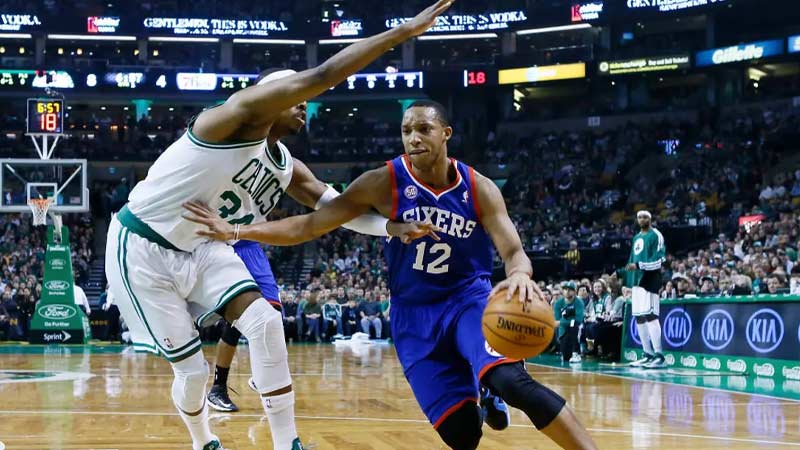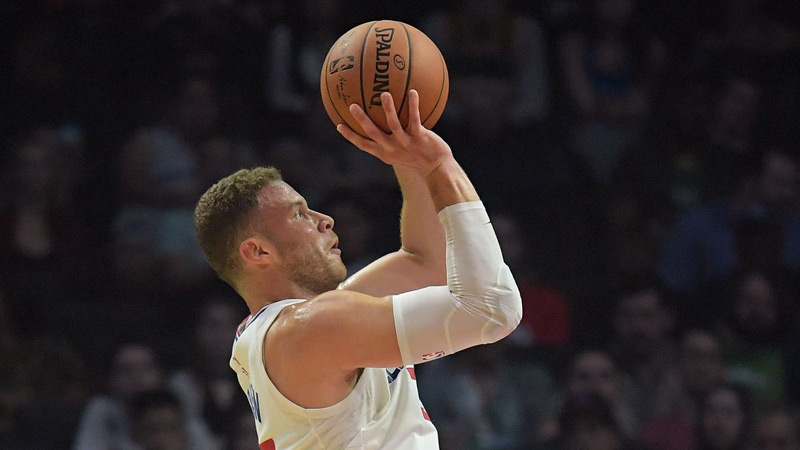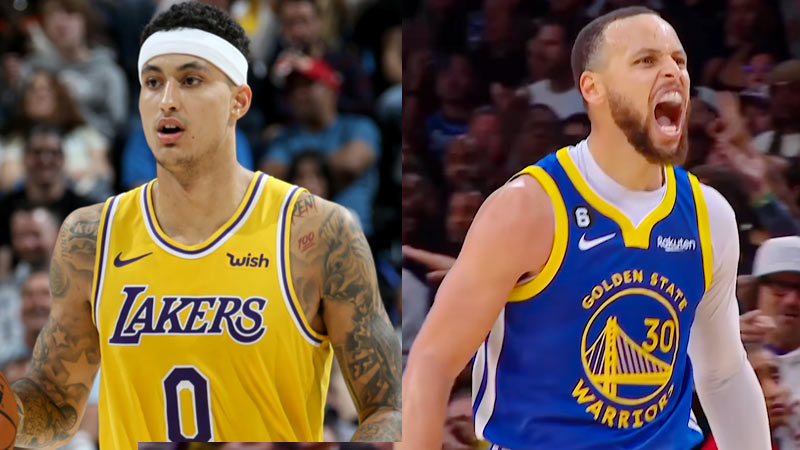When it comes to basketball, each position on the court carries unique roles and responsibilities. Among these positions, the small forward and power forward stand out as vital components of a team’s lineup.
While there may be some similarities between them, understanding the differences between these two positions is crucial for both players and fans alike.
In this blog post, we will delve into the contrasting characteristics, offensive and defensive roles, and playing styles of small forwards and power forwards, shedding light on the distinct aspects that set them apart.
What is Small Forward in Basketball?
In basketball, the small forward is a position typically referred to as the “3” and is one of the five positions on the court. The small forward generally plays on the perimeter and is known for their versatility and scoring ability. Here are some key characteristics and responsibilities of a small forward:
Size and Physical Attributes
Small forwards are usually taller and stronger than point guards and shooting guards but smaller than power forwards and centers. They typically range in height from 6’6″ to 6’9″ (1.98 to 2.06 meters) and possess a combination of speed, agility, and athleticism.
Scoring
Small forwards are often primary scoring options for their teams. They have the ability to shoot from the perimeter, drive to the basket, and score in various ways. They are expected to have solid shooting skills, including mid-range jumpers and three-point shooting.
Rebounding
Small forwards are also responsible for rebounding, both on the offensive and defensive ends of the court. They must use their size and athleticism to secure rebounds and start fast breaks or maintain possession for their team.
Defense
Small forwards play an important role on the defensive end. They must guard opposing small forwards, as well as potentially switch onto guards or bigger forwards. Their defensive responsibilities include contesting shots, defending drives, and providing help defense when needed.
Versatility
Small forwards are often considered the “Swiss Army knife” of basketball. They are expected to contribute in various aspects of the game, including scoring, rebounding, passing, and defending. They need to be able to adapt to different situations and play multiple positions if required.
Notable NBA players who have excelled in the small forward position include LeBron James, Kevin Durant, Larry Bird, Scottie Pippen, and Kawhi Leonard. However, it’s important to note that basketball is a dynamic sport, and player roles and positions can vary depending on team strategies and individual skills.
Roles of Small Forward in Basketball

Source: sportsbrief.com
The small forward in basketball has several key roles and responsibilities on the court. Here are some of the common roles associated with the small forward position:
Scoring
Small forwards are often expected to be primary scoring options for their team. They contribute to the team’s offense by shooting from the perimeter, driving to the basket, and scoring in various ways. They must have a versatile scoring repertoire and the ability to create their own shot.
Three-Point Shooting
Small forwards are often relied upon to stretch the defense by shooting three-pointers. Their outside shooting ability opens up the floor, creates spacing, and forces defenders to guard them closely, which can open up opportunities for their teammates.
Rebounding
Small forwards play a role in rebounding on both ends of the court. They must use their size, athleticism, and positioning to grab rebounds, particularly on the defensive end, to end opponents’ possessions and start fast breaks for their team.
Defense
Small forwards are typically responsible for guarding the opposing team’s small forward. They must have the ability to defend both on the perimeter and in the post. Small forwards need to contest shots, stay in front of their opponents, and provide help defense when necessary.
Playmaking
Small forwards often contribute to the team’s playmaking and passing. They are expected to have solid passing skills and court vision, enabling them to make accurate passes to open teammates and create scoring opportunities for others.
Versatility
Small forwards are known for their versatility and ability to play multiple positions if needed. They may be asked to guard different positions on defense, including guards and power forwards, depending on the team’s defensive strategy. Their versatility also allows them to contribute in various ways on offense.
Leadership and Intangibles
Small forwards, especially those who are experienced and established, often provide leadership on the court. They may be relied upon to make critical decisions, motivate their teammates, and set an example through their work ethic and professionalism.
It’s important to note that the specific roles and responsibilities of a small forward can vary depending on the team’s style of play, coaching strategies, and the individual player’s skill set.
Different players may emphasize certain aspects of the position more than others, and their roles may evolve throughout their careers.
What is Power Forward in Basketball?

Source: blazersedge.com
In basketball, the power forward is a position typically referred to as the “4” and is one of the five positions on the court. The power forward plays a key role in both offense and defense, combining size, strength, and versatility.
Here are some key characteristics and responsibilities of a power forward:
Size and Physical Attributes
Power forwards are generally taller and stronger than small forwards but smaller than centers. They typically range in height from 6’8″ to 6’10” (2.03 to 2.08 meters) and possess a combination of strength, athleticism, and mobility.
Inside Scoring
Power forwards often contribute to the team’s scoring by operating in the low post or mid-range area. They use their size and strength to score close to the basket through post moves, putbacks, and offensive rebounds. They may also have the ability to shoot from mid-range.
Rebounding
Power forwards are crucial in securing rebounds, particularly on the defensive end. They use their size and strength to battle for position and grab rebounds to end opponents’ possessions and start fast breaks for their team. They are often relied upon to provide second-chance opportunities through offensive rebounds.
Defense
Power forwards play a significant role on the defensive end of the court. They must be able to guard opposing power forwards, as well as switch onto smaller players or help defend against drives to the basket. Their defensive responsibilities include contesting shots, protecting the paint, and providing help defense.
Stretch Four
In modern basketball, some power forwards have developed the ability to shoot three-pointers consistently. These players are referred to as “stretch fours” as they stretch the defense by drawing opposing big men away from the basket, opening up driving lanes and creating spacing for their teammates.
Pick-and-Roll/Pick-and-Pop
Power forwards are often involved in pick-and-roll or pick-and-pop situations. They set screens for their teammates and can roll to the basket or pop out to the perimeter for jump shots, creating scoring opportunities and forcing defensive adjustments.
Versatility
Like small forwards, power forwards are expected to have some level of versatility. They may be called upon to play multiple positions, switch defensively, and contribute in different aspects of the game, such as passing and ball-handling.
Roles of Power Forward in Basketball
The power forward in basketball has several important roles and responsibilities on the court. Here are some common roles associated with the power forward position:
Scoring
Power forwards are often expected to contribute to the team’s scoring output. They can score in various ways, including inside the paint with post moves, offensive rebounds, and mid-range jumpers. Some power forwards also possess the ability to shoot from beyond the arc, adding an outside scoring threat.
Rebounding
Power forwards play a crucial role in rebounding, particularly on the defensive end. Their size, strength, and positioning allow them to secure rebounds, denying opponents second-chance opportunities and initiating fast breaks for their team.
Interior Defense
Power forwards are responsible for defending the paint and protecting the rim. They use their size, strength, and shot-blocking ability to contest shots, alter opponents’ attempts, and deter drives to the basket. They are also expected to help on defense, providing support in pick-and-roll situations or rotations.
Pick-and-Roll
Power forwards often participate in pick-and-roll plays. They set screens for their teammates, roll to the basket, and create scoring opportunities by receiving passes for layups or dunks. They must have good timing, communication, and decision-making skills to execute effective pick-and-roll plays.
Stretch Four
In modern basketball, some power forwards have developed their shooting range to include three-point shots. These players are known as “stretch fours” and provide an added dimension to the team’s offense. They draw defenders away from the basket, creating spacing and opening driving lanes for teammates.
Mid-Range Shooting
Power forwards often possess a reliable mid-range jump shot. This helps stretch the defense, as they can knock down shots from the elbows or baseline. It also creates offensive opportunities by forcing defenders to close out, which can lead to drives or passing lanes.
Versatility
Power forwards are expected to be versatile and adapt to different game situations. They may need to guard various positions on defense, switch onto smaller or larger opponents, and contribute in different aspects of the game, such as passing and ball-handling. Their versatility allows coaches to employ different strategies and lineups.
Small Forward Vs. Power Forward: Basic Differences
The small forward and power forward positions in basketball have distinct roles and responsibilities on the court. While there can be some overlap in certain aspects, there are several key differences between the two positions. Here’s a detailed breakdown of the basic differences:
Physical Attributes
Small forwards typically have a height range of 6’6″ to 6’9″ (1.98 to 2.06 meters) and possess a combination of speed, agility, and athleticism. They are usually smaller and more agile than power forwards.
Power forwards are generally taller and stronger than small forwards, ranging in height from 6’8″ to 6’10” (2.03 to 2.08 meters). They have a greater emphasis on strength and physicality, allowing them to hold their ground in the post and battle for rebounds.
Offensive Roles
Small forwards often serve as primary or secondary scoring options for their team. They have the ability to shoot from the perimeter, drive to the basket, and score in various ways.
They may have a well-rounded offensive game and contribute as playmakers and facilitators. On the other hand, power forwards play a significant role in scoring, particularly in the low post or mid-range area.
They use their size, strength, and post moves to score close to the basket. While some power forwards have developed a mid-range or three-point shot, their scoring contributions generally come from inside the paint.
Rebounding
Small forwards are responsible for rebounding, both on the offensive and defensive ends of the court. They use their athleticism and positioning to grab rebounds and start fast breaks or maintain possession for their team. However, their rebounding impact may be less significant than that of power forwards.
On the contrary, power forwards play a crucial role in rebounding, particularly on the defensive end. They use their size, strength, and positioning to secure rebounds, denying opponents second-chance opportunities and initiating fast breaks for their team. They are often relied upon for their rebounding prowess.
Defensive Roles
Small forwards have defensive responsibilities that involve guarding opposing small forwards and potentially switching onto guards or bigger forwards. They need to stay in front of their opponents, contest shots, and provide help defense when needed.
Power forwards are responsible for defending the paint and protecting the rim. They use their size, strength, and shot-blocking ability to contest shots, deter drives to the basket, and provide interior defense.
They may also guard power forwards or centers, using their physicality to disrupt opponents’ post-plays.
Playing Style and Versatility
Small forwards are often considered versatile players who can adapt to different game situations. They contribute to various aspects of the game, including scoring, rebounding, passing, and defending. Their skill set allows them to play multiple positions if required.
Power forwards tend to have a more specific role as interior players who excel in scoring close to the basket, rebounding, and providing defensive presence. While they may have some versatility, their focus is primarily on the physical aspects of the game.
It’s important to note that basketball is a dynamic sport, and player roles can evolve based on team strategies, individual skills, and the evolving nature of the game. Some players may possess qualities of both small forwards and power forwards, blurring the lines between the positions.
Additionally, the style of play and the specific needs of the team may influence how players are deployed and the responsibilities assigned to them.
FAQs
What are the main differences in size and physical attributes between small forwards and power forwards?
Small forwards are typically smaller, ranging from 6’6″ to 6’9″ (1.98 to 2.06 meters), and possess agility and athleticism.
Power forwards are generally taller, standing between 6’8″ to 6’10” (2.03 to 2.08 meters), and focus more on strength and physicality.
How do their offensive roles differ?
Small forwards often serve as primary or secondary scoring options, utilizing their shooting abilities and driving skills.
Power forwards contribute to scoring primarily through low-post moves, relying on their size and strength to score near the basket.
What are the contrasting rebounding responsibilities of small forwards and power forwards?
Small forwards have rebounding duties on both ends of the court, utilizing their athleticism to secure rebounds.
Power forwards play a more significant role in rebounding, using their size and physicality to grab defensive rebounds and provide second-chance opportunities.
How do their defensive roles differ?
Small forwards primarily guard opposing small forwards and may switch onto guards or bigger forwards when required.
Power forwards defend the paint, protecting the rim and providing interior defense against opponents’ post plays.
Are there differences in versatility and playing style?
Small forwards are often considered versatile players, contributing to various aspects of the game, including scoring, rebounding, passing, and defending.
Power forwards focus more on their interior game, specializing in scoring near the basket, rebounding, and providing a defensive presence.
Wrapping Up
Understanding the distinctions between small forwards and power forwards is essential for basketball enthusiasts, coaches, and players alike.
While small forwards rely on their athleticism and versatility to contribute across multiple facets of the game, power forwards excel in scoring near the basket, rebounding, and providing a defensive presence.
By grasping these differences, fans can appreciate the unique roles each position plays on the court, and players can tailor their skills and strategies to suit the demands of their specific position.
Whether it’s the finesse of a small forward or the physicality of a power forward, both positions bring valuable contributions to the team dynamic, enriching the sport we all love. Best wishes.







